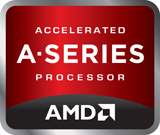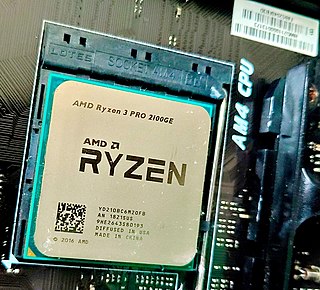Related Research Articles

Advanced Micro Devices, Inc. (AMD) is an American multinational corporation and semiconductor company based in Santa Clara, California, that develops computer processors and related technologies for business and consumer markets.
The transistor count is the number of transistors in an electronic device. It is the most common measure of integrated circuit complexity. The rate at which MOS transistor counts have increased generally follows Moore's law, which observes that transistor count doubles approximately every two years. However, being directly proportional to the area of a die, transistor count does not represent how advanced the corresponding manufacturing technology is. A better indication of this is transistor density which is the ratio of a semiconductor's transistor count to its die area.

AMD Accelerated Processing Unit (APU), formerly known as Fusion, is a series of 64-bit microprocessors from Advanced Micro Devices (AMD), combining a general-purpose AMD64 central processing unit (CPU) and 3D integrated graphics processing unit (IGPU) on a single die.
Zen is the codename for a family of computer processor microarchitectures from AMD, first launched in February 2017 with the first generation of its Ryzen CPUs. It is used in Ryzen, Ryzen Threadripper, and Epyc (server).

Zen is the codename for the first iteration in a family of computer processor microarchitectures of the same name from AMD. It was first used with their Ryzen series of CPUs in February 2017. The first Zen-based preview system was demonstrated at E3 2016, and first substantially detailed at an event hosted a block away from the Intel Developer Forum 2016. The first Zen-based CPUs, codenamed "Summit Ridge", reached the market in early March 2017, Zen-derived Epyc server processors launched in June 2017 and Zen-based APUs arrived in November 2017.

Zen 2 is a computer processor microarchitecture by AMD. It is the successor of AMD's Zen and Zen+ microarchitectures, and is fabricated on the 7 nm MOSFET node from TSMC. The microarchitecture powers the third generation of Ryzen processors, known as Ryzen 3000 for the mainstream desktop chips, Ryzen 4000U/H and Ryzen 5000U for mobile applications, as Threadripper 3000 for high-end desktop systems, and as Ryzen 4000G for accelerated processing units (APUs). The Ryzen 3000 series CPUs were released on 7 July 2019, while the Zen 2-based Epyc server CPUs were released on 7 August 2019. An additional chip, the Ryzen 9 3950X, was released in November 2019.

Ryzen is a brand of multi-core x86-64 microprocessors designed and marketed by Advanced Micro Devices (AMD) for desktop, mobile, server, and embedded platforms based on the Zen microarchitecture. It consists of central processing units (CPUs) marketed for mainstream, enthusiast, server, and workstation segments and accelerated processing units (APUs) marketed for mainstream and entry-level segments and embedded systems applications.
Zen+ is the codename for a computer processor microarchitecture by AMD. It is the successor to the first gen Zen microarchitecture, and was first released in April 2018, powering the second generation of Ryzen processors, known as Ryzen 2000 for mainstream desktop systems, Threadripper 2000 for high-end desktop setups and Ryzen 3000G for accelerated processing units (APUs).

Epyc is a brand of multi-core x86-64 microprocessors designed and sold by AMD, based on the company's Zen microarchitecture. Introduced in June 2017, they are specifically targeted for the server and embedded system markets.
The Radeon RX Vega series is a series of graphics processors developed by AMD. These GPUs use the Graphics Core Next (GCN) 5th generation architecture, codenamed Vega, and are manufactured on 14 nm FinFET technology, developed by Samsung Electronics and licensed to GlobalFoundries. The series consists of desktop graphics cards and APUs aimed at desktops, mobile devices, and embedded applications.

Socket SP3 is a zero insertion force land grid array CPU socket designed by AMD supporting its Zen-, Zen 2- and Zen 3-based Epyc server processors, launched on June 20, 2017. Because the socket is the same size as socket TR4 and socket sTRX4, users can use CPU coolers not only designed for SP3, but also coolers designed for TR4 and sTRX4.

Zen 4 is the codename for a CPU microarchitecture designed by AMD, released on September 27, 2022. It is the successor to Zen 3 and uses TSMC's N6 process for I/O dies, N5 process for CCDs, and N4 process for APUs. Zen 4 powers Ryzen 7000 performance desktop processors, Ryzen 8000G series mainstream desktop APUs, and Ryzen Threadripper 7000 series HEDT and workstation processors. It is also used in extreme mobile processors, thin & light mobile processors, as well as EPYC 8004/9004 server processors.

Zen 3 is the codename for a CPU microarchitecture by AMD, released on November 5, 2020. It is the successor to Zen 2 and uses TSMC's 7 nm process for the chiplets and GlobalFoundries's 14 nm process for the I/O die on the server chips and 12 nm for desktop chips. Zen 3 powers Ryzen 5000 mainstream desktop processors and Epyc server processors. Zen 3 is supported on motherboards with 500 series chipsets; 400 series boards also saw support on select B450 / X470 motherboards with certain BIOSes. Zen 3 is the last microarchitecture before AMD switched to DDR5 memory and new sockets, which are AM5 for the desktop "Ryzen" chips alongside SP5 and SP6 for the EPYC server platform and sTRX8. According to AMD, Zen 3 has a 19% higher instructions per cycle (IPC) on average than Zen 2.
References
- ↑ "AMD Ryzen 8000 "Strix Point" APU Leak Points to 16 RDNA 3.5 CUs". TechPowerUp. September 4, 2023. Retrieved October 7, 2023.
- ↑ "AMD Ryzen 8000 "Hawk Point" officially in upcoming Minisforum 2-in-1 tablet". VideoCardz.com. Retrieved October 7, 2023.
- ↑ "AMD confirms Zen4 & Ryzen 7000 series lineup: Raphael in 2022, Dragon Range and Phoenix in 2023". VideoCardz. May 3, 2022. Retrieved October 2, 2022.
- ↑ Bonshor, Gavin (June 2, 2024). "AMD Unveils Ryzen 9000 CPUs For Desktop, Zen 5 Takes Center Stage at Computex 2024". AnandTech. Archived from the original on June 3, 2024. Retrieved June 2, 2024.
- ↑ "AMD Ryzen 8000 CPUs to be Based on 4nm Node (Not 3nm), 5th Gen Epyc to Get 3nm [Rumor]". Hardware Times. April 29, 2023. Retrieved August 4, 2023.
- ↑ Alcorn, Paul (June 9, 2022). "AMD Shares New CPU Core Roadmap, 3nm Zen 5 by 2024, 4th-Gen Infinity Architecture". Tom's Hardware. Retrieved August 4, 2023.
- ↑ Bonshor, Gavin (June 9, 2022). "AMD's Desktop CPU Roadmap: 2024 Brings Zen 5-based "Granite Ridge"". AnandTech. Retrieved June 11, 2022.
- ↑ Allan, Darren (January 26, 2024). "AMD Zen 5 chips could turn up in April, but you'll have to be patient for the most powerful next-gen desktop CPUs". TechRadar. Retrieved February 2, 2024.
- ↑ Alcorn, Paul (June 2, 2024). "AMD announces 3nm EPYC Turin with 192 cores and 384 threads — 5.4X faster than Intel Xeon in AI work, launches second half of 2024". Archived from the original on June 3, 2024. Retrieved June 2, 2024.
- ↑ Alcorn, Paul (June 2, 2024). "AMD unwraps Ryzen AI 300 series 'Strix Point' processors — 50 TOPS of AI performance, Zen 5c density cores come to Ryzen 9 for the first time". Tom's Hardware. Archived from the original on June 3, 2024. Retrieved June 2, 2024.
- ↑ "AMD FAD 2022 AMD CPU Core Roadmap To Zen 5". ServeTheHome. Retrieved June 3, 2024.
- ↑ "AMD reaffirms Ryzen CPUs with Zen5 architecture are coming in the second half of 2024". VideoCardz. January 31, 2024. Retrieved June 3, 2024.
- ↑ Bonshor, Gavin (June 2, 2024). "AMD Unveils Ryzen 9000 CPUs For Desktop, Zen 5 Takes Center Stage at Computex 2024". AnandTech. Retrieved June 3, 2024.
- ↑ Norem, Josh (July 14, 2023). "Analyst: TSMC Hitting 55% Yields on 3nm Node for Apple's A17 Bionic, M3 SoCs". ExtremeTech. Retrieved June 3, 2024.
- ↑ Shilov, Anton (December 31, 2022). "Analysts Estimate TSMC's 3nm Yields Between 60% and 80%". Tom's Hardware. Retrieved June 3, 2024.
- ↑ Norem, Josh (August 8, 2023). "Apple Bought All of TSMC's 3nm Capacity for an Entire Year". ExtremeTech. Retrieved June 3, 2024.
- ↑ Norem, Josh (April 27, 2023). "TSMC Says It Can't Keep Up With Apple's Demands for 3nm Wafers". ExtremeTech. Retrieved June 3, 2024.
- ↑ "Advanced Technologies for HPC: N4/N4P/N4X". TSMC. Retrieved June 3, 2024.
- ↑ Shilov, Anton (December 17, 2021). "TSMC Unveils N4X Node: Extreme High-Performance at High Voltages". AnandTech. Retrieved June 3, 2024.
- 1 2 "AMD introduces Ryzen 9000 Zen5 desktop CPUs "Granite Ridge"". VideoCardz. June 3, 2024. Retrieved June 3, 2024.
- ↑ "Zen 5's Leaked Slides". Chips and Cheese. October 8, 2023. Retrieved June 3, 2024.
- ↑ Mujtaba, Hassan (June 2, 2024). "AMD Ryzen 9000 Desktop CPUs Official: Zen 5 Achieves 16% IPC Uplift, 9950X, 9900X, 9700X, 9600X SKUs, Up To 16 Cores At 5.7 GHz, July Launch". Wccftech. Retrieved June 3, 2024.
- ↑ Cunningham, Andrew (September 27, 2022). "Everything you need to know about Zen 4, socket AM5, and AMD's newest chipsets". Ars Technica. Retrieved June 3, 2024.
- ↑ Alcorn, Paul (June 3, 2024). "AMD unwraps Ryzen AI 300 series 'Strix Point' processors — 50 TOPS of AI performance, Zen 5c density cores come to Ryzen 9 for the first time". Tom's Hardware. Retrieved June 3, 2024.
- 1 2 Alcorn, Paul (June 3, 2024). "AMD announces 3nm EPYC Turin with 192 cores and 384 threads — 5.4X faster than Intel Xeon in AI work, launches second half of 2024". Tom's Hardware. Retrieved June 3, 2024.
- ↑ Smith, Ryan (June 9, 2022). "AMD Zen Architecture Roadmap: Zen 5 in 2024 With All-New Microarchitecture". AnandTech. Retrieved December 11, 2022.